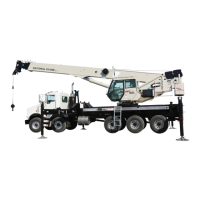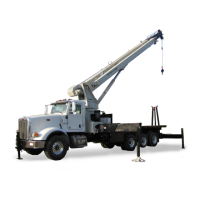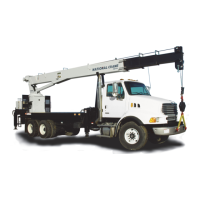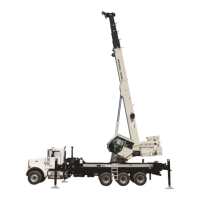NBT50 OPERATOR MANUAL CONTROLS AND OPERATING PROCEDURES
National Crane Published 03-23-2018 Control # 243-14 3-17
HOIST SYSTEM OPERATION
The Hoist may have lifting capabilities greater than that of the
crane limits. Therefore, care must be taken to ensure that the
load lifted is within the crane rating. General rules for hoist
operation are:
• Unwind the hoist when extending the boom.
• Use the anti-two-block system only as an aid.
• Make sure the rope is not twisted or kinked and that it is
properly seated in the hoist and in sheaves.
• Always have at least three full wraps of cable on the
hoist.
• Check the hoist brake when approaching the load limit of
the hoist. Raise the load a few inches and return the
control to neutral to check the brake.
• Do not drag the load with the hoist.
• Do not try to lift loads that are not free such as, frozen
down material or poles.
• Keep tension on the rope to prevent it from becoming
twisted, kinked, or improperly seated on the hoist.
WORK SITE LOCATION
Select a location that is firm, level, and dry. Avoid uneven,
rocky or muddy terrain, steep grade or locations with
overhead obstructions. The outrigger jacks must be
supported on a firm level surface at the fully retracted,
mid-span, or fully extended positions. Avoid overhead power
lines.
Before Leaving the Truck Cab
• Position the truck so that the outriggers can be extended
with no obstructions.
• Position the truck transmission to neutral.
• Set the truck park brake. Wheel chocks may also be
required.
• Engage the power takeoff.
• Turn the truck cab ignition switch to OFF.
Stowing and Parking
When parking the crane, it should be placed in the smallest,
most stable operational configuration that the job site
practically allows by doing the following steps:
1. Park the crane on a stable surface.
2. Remove the load from the hook.
3. Stow the swingaway jib, if erected.
4. Fully retract the boom and position it in the normal travel
position, then perform the following and proceed to
Step 6:
a. Engage the swing brake and/or swing lock.
b. Retract all jack cylinders and outrigger beams.
5. If it is not practical to fully retract the boom and place it in
the travel position, then perform the following and
proceed to Step 6:
a. Make the crane as stable as possible, including,
boom angle, superstructure orientation, jib angle,
etc. In high winds, the boom and jibs should be
lowered or secured.
b. Engage the swing brake and/or swing lock.
6. Apply the parking brake.
7. Put all operating controls in the neutral position.
8. Position the Crane Function switch to OFF.
9. Shut down the engine following the proper procedures
specified in this manual and the applicable engine
manual.
10. Remove the keys.
DANGER
A deviation between displayed and actual values
indicates a malfunction and a RCL service representative
shall be called for repair and/or recalibration of RCL
system.
DANGER
Truck must be in neutral with the park brake set before
starting engine from crane cab to avoid sudden potential
movement of truck.
WARNING
Tipping Hazard!
Never park the crane near holes, or on rocky or extremely
soft surfaces. This may cause the crane to overturn.
Failure to comply with these instructions may cause death
or serious injury.
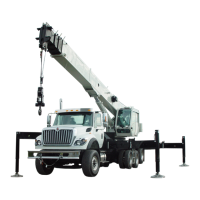
